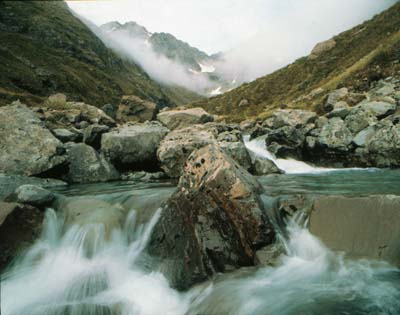 |
 |
| current issue |  |
past issues |  |
send a letter/news |  |
address update |  |
advertise |  |
about us |  |
alumni home |
Features
Classroom with a ViewPage 2 of 3
 Field leader Karapiro Boyd has a close encounter with a giant weta, a wingless cricket found only in New Zealand.
Field leader Karapiro Boyd has a close encounter with a giant weta, a wingless cricket found only in New Zealand.
|
Humans, who finally arrived between 900 and 1200 A.D. with their dogs and Pacific rats (and later their cats, weasels, ferrets and stoats), drove dozens of New Zealand's species to extinction. Today, many more remain endangered, including the country's icon, the kiwi. Ninety-five percent of these flightless birds succumb to predators while still juveniles. Then there's the kea, an inquisitive mountain parrot that peels strips of rubber from car windows and pops the tops off of beer cans. The kakapo, another ancient parrot—and the world's only flightless one—weighs in at more than eight pounds and has a voice like a bagpipe. Fewer than 100 still exist.
Since the early 1900s, New Zealanders have been working to save many of these indigenous species and have become world leaders in ecosystem- and species- restoration efforts. "What makes New Zealand so attractive from a science perspective," says Kim Babbitt '84, associate professor of wildlife ecology and EcoQuest's academic program coordinator at UNH, "is that we face the same challenges in the United States, but the magnitude of the problem in New Zealand is so severe that it really makes an impression on students."
The first group of EcoQuesters—all 10 of them—arrived in September 1999. Today, the program's promise of "ecology in action" lures close to 60 students a year. "We start off with the conceptual learning skills that the old scientists had," says John Longden, an EcoQuest field leader. "They looked and they thought. Then they asked themselves, 'OK, what is happening here?'"
Along with analyzing ecosystems, students also learn to read the political subtext, the complex tangle of issues that have a bearing on the future of the natural environment. The program's larger aim is to produce "ecosystem decision makers," leaders with field experience who also understand the underlying concepts and are primed to take action.
"EcoQuest is so much more than a 'trip abroad,'" says Babbitt. For one thing, it draws on the expertise of New Zealanders, from environmental lawyers to policy specialists. "There are many significant conservation and management issues in the country, so the students are actively engaged with ongoing restoration efforts. Their work is not just an exercise—it has real value for New Zealand," she adds.
 Photo of Upper Otira Valley in Arthur's Pass National Park
Photo of Upper Otira Valley in Arthur's Pass National Parkby Craig Potton |
EcoQuest "campus" is an assortment of structures, including various academic buildings, a dining hall and several cabins. A makeshift volleyball court is marked by shoes and hats. But there's not much time for play. When I arrived, two weeks into the program, this group of 24 recruits—11 of them from UNH—had already been trained in basic forest and water safety and had completed two wilderness excursions. They had also been formally welcomed by the local Maori tribe, Ngati Poaoa, and received an in-depth rundown on the political, legal and procedural issues driving New Zealand's environmental management. They celebrated New Zealand's national day, and some shook hands with the country's prime minister. Working on average six days a week, the students took in a steady diet of lectures, discussions and activities in the field.
Just a few days after arrival, for example, when they still qualified as FOBs ("fresh off the boat"), they confronted a Gondoresque rock outcropping called the Pinnacles. The challenge was blunt: Without any prior knowledge of the biology or ecology of this place, what observations and explanations can you muster about the environment?
"We were supposed to figure out what we were seeing from hints they gave us," recalls Dave Fry '05, an environmental conservation major from UNH. "Nothing was obvious." The academic challenge was tough enough. And then there was the rain. The students wrote with waterproof pencils on waterproof paper. They crossed rushing rivers. As they hiked through different elevations, picking their way through the mud, they discussed the impacts of land use on forest succession and the underlying geology and soils. After the first half hour, their raincoats were useless.
"I could not believe that 24 people who hardly knew each other could have a coherent discussion in the pouring rain on a trail that was hardly wide enough for two people," says Iris Levine, a biology major from Bowdoin. By 5:30 a.m., however, the rain had stopped and the students watched the sun rise over the ocean. "It was so beautiful, it was a little intimidating—360 degrees of beauty," she says.
Page: < Prev 1 2 3 Next >Easy to print version

